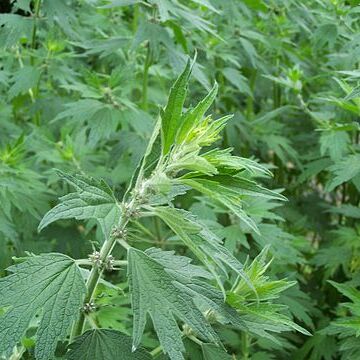Cal turbinate, 5–10-nerved, the lobes prolonged into stiff slender spines, the 2 lower often slightly larger or deflexed; cor strongly bilabiate, the upper lip entire and galeately rounded, the lower spreading or deflexed, 3-lobed, with obcordate central lobe and oblong lateral lobes; stamens 4, ascending under the upper lip, the lower pair equaling or longer than the upper; pollen-sacs mostly parallel; nutlets triquetrous, truncate and hairy at the top; erect herbs with toothed or cleft, petiolate lvs and white to pink fls crowded in dense verticils subtended by bracteal lvs and by linear to subulate bracts; forming long, interrupted terminal spikes. 10, mostly temp. Eurasia.
Erect herbs. Leaves often lobed or palmate-pinnately dissected. Verticillasters of numerous flowers axillary. Bracts subulate. Calyx turbinate, 5-nerved and 5-toothed, teeth more or less equal, spinescent, spreading. Corolla naked or annulate within, 2-lipped; upper lip entire, erect, convex; lower lip 3-lobed, midlobe very large, deeply notched. Stamens 4, in 2 pairs, ascending under the upper lip; lower pair slightly longer; anthers 2-celled, cells parallel, connivent. Disk uniform. Style equally 2-fid, branches obtuse or subulate. Nutlets dry, smooth, triquetrous, truncate at apex.
Biennial or perennial herbs, sometimes rhizomatous. Lvs digitately lobed or undivided. Infl. spike-like, of many-flowered dense verticels, in crowded or distant axillary whorls. Bracts leaflike. Calyx campanulate, not gibbous at base, 5-or 10-nerved; teeth 5, spinose, subequal. Corolla 2-lipped; tube < calyx; throat not dilated; upper lip hooded, hairy on back; lower lip 3-lobed. Anthers parallel or divergent; cells opening by a common slit. Style gynobasic, its branches equal. Nutlets trigonous; apex truncate.

